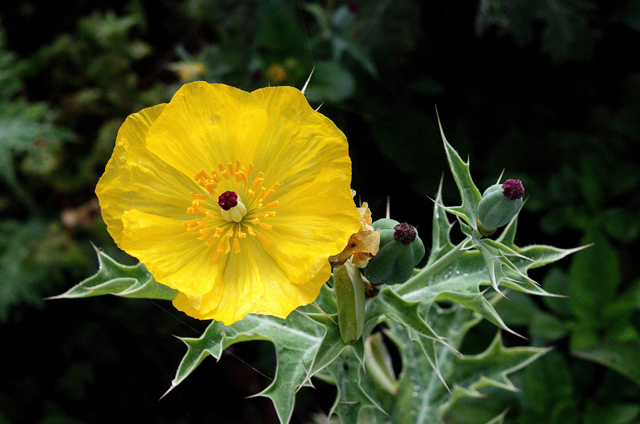Mexican pricklypoppy
Pictured above: All but the petals of Mexican pricklypoppy (Argemone mexicana) are covered in sharp spines.
Photo by R.W. Smith, Lady Bird Johnson Wildflower Center. Click on terms for botanical definitions. View post as a PDF
Also known as Yellow pricklypoppy, Mexican pricklypoppy is an eye-catching wildflower with an imposing presence. Its brilliant blooms are quite attractive, but don’t get too close — the rest of the plant is armed with sharp spines. It blooms winter through summer, typically peaking in early spring and drawing a variety of pollinators. The plant is often spotted in open, disturbed sites and along roadsides throughout much of Florida.
Mexican pricklypoppy’s showy yellow to yellowish-orange flowers are 1–3 inches wide and cup-shaped with six petals that often appear crumpled. Stamens are numerous with yellow filaments and yellow to reddish-orange anthers. Pistils are topped with a dark reddish-orange stigma. Flowers are subtended with bracts. Calyces are composed of three spine-tipped sepals. Stems are branched and arise from a basal rosette of long, deeply lobed leaves with prickly margins. The young rosette may be misidentified as a thistle (Cirsium spp.). Leaves are sessile, clasping and alternately arranged. Leaf surface is glaucous, giving the plant a whitish or silvery hue. Fruit is a spine-covered capsule.
The plant is poisonous if ingested but has been used medicinally by many cultures. Seed capsules and stems emit a toxic yellowish latex when split open. The seeds contain a pale-yellow oil (also known as katkar oil) that is also toxic. The oil may be used for lighting and as an insecticide.
Family: Papaveraceae (Poppy family)
Native range: Nearly throughout peninsula, few Panhandle counties
To see where natural populations of Mexican pricklypoppy have been vouchered, visit florida.plantatlas.usf.edu.
Hardiness: Zones 8–11
Lifespan: Annual
Soil: Dry, well-drained sandy soils
Exposure: Full sun
Growth habit: 1–3’ tall, ±1’ wide
Propagation: Seed
Garden tips: Mexican pricklypoppy’s conspicuous golden blooms and armored foliage add interest to wildflower and pollinator gardens. However, all parts of the plant except the petals are covered in sharp spines, making it difficult to handle. Plants die after setting seed in late spring or summer and should be carefully removed. Seeds will readily germinate in open areas with direct soil contact. Be sure seeds are placed where the plant is wanted, as Mexican pricklypoppy’s deep taproot does not tolerate transplantation well.

